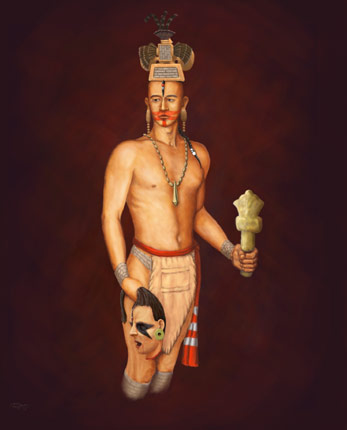|
Wa People
The Wa people ( Wa: Vāx; my, ဝလူမျိုး, ; ; th, ว้า) are a Southeast Asian ethnic group that lives mainly in Northern Myanmar, in the northern part of Shan State and the eastern part of Kachin State, near and along Myanmar's border with China, as well as in China's Yunnan Province. Historically, the Wa have inhabited the Wa States, a territory that they have claimed as their ancestral land since time immemorial. It is a rugged mountainous area located between the Mekong and the Salween River, with the Nam Hka flowing across it. The Wa traditionally practiced subsistence agriculture by cultivating rice, peas, beans, poppies and walnuts. They bred water buffaloes, which they used mainly for sacrificial purposes. Generally, the traditional customs of the Wa, as well as their lifestyle, are very similar to those of the Naga people further to the Northwest. The Wa people speak the Wa language which are part of the Mon-Khmer group of languages. Many ... [...More Info...] [...Related Items...] OR: [Wikipedia] [Google] [Baidu] |
Wa States
The Wa States was the name formerly given to the Wa Land, the natural and historical region inhabited mainly by the Wa people, an ethnic group speaking an Austroasiatic language. The region is located to the northeast of the Shan States of British Burma, in the area of present-day Shan State of northern Burma (Myanmar) and the western zone of Pu'er Prefecture, Yunnan, China. Practically the whole Wa region is rugged mountainous territory with steep hills and deep valleys. There were no urban areas. A section of the historical Wa territory was included in the state of Manglon, one of the Shan States. Sir James George Scott visited the Wa States around the turn of the century and wrote about the place, taking pictures of the people and the houses of the area as well. Considered a distant and inaccessible border area by former empires, the British census of 1901 did not include the Wa States, so statistics regarding a population over 50,000 in 1911 are estimates. The oral ... [...More Info...] [...Related Items...] OR: [Wikipedia] [Google] [Baidu] |
Salween River
, ''Mae Nam Salawin'' ( , name_etymology = , image = Sweet_View_of_Salween_River_in_Tang_Yan_Township,_Shan_State,_Myanmar.jpg , image_size = , image_caption = Salween River in Shan State, Myanmar , map = Salween river basin map.png , map_size = , map_caption = Map of the Salween River basin , pushpin_map = , pushpin_map_size = , pushpin_map_caption= , subdivision_type1 = Country , subdivision_name1 = China, Myanmar (Burma), Thailand , subdivision_type2 = Provinces (PRC) , subdivision_name2 = Tibet Autonomous Region, Yunnan , subdivision_type3 = States (Myanmar) , subdivision_name3 = Shan, Karenni (Kayah), Karen (Kayin), Mon , subdivision_type4 = Province (Thailand) , subdivision_name4 = Mae Hong Son , length = Lehner, B., Verdin, K., Jarvis, A. (2008)New global hydrography derived from spaceborne elevation data Eos, Transactions, AGU, 89(10): 93–94. , widt ... [...More Info...] [...Related Items...] OR: [Wikipedia] [Google] [Baidu] |
James George Scott
Sir James George Scott (pseudonym Shway Yoe, 25 December 1851 – 4 April 1935) was a Scottish journalist and colonial administrator who helped establish British colonial rule in Burma, and in addition introduced football to Burma. Life He was born in Dairsie, the second son of Mary Forsyth and Rev. George Scott, a Presbyterian minister. His elder brother was Robert Forsyth Scott, who was to become Master of St John's College, Cambridge. Three years after the death of Rev. Scott, Mary moved with her two sons to Stuttgart, where they lived until the outbreak of the Austro-Prussian War. After returning to the United Kingdom, Scott was educated at King's College School. He went on to Lincoln College, but was unable to complete his studies there due to a decline in the family fortune. He worked first as a journalist. For the London ''Evening Standard'' he covered the reprisals for the murder of J. W. W. Birch, in Perak, in 1875. He then reported from Burma, usually in Rangoo ... [...More Info...] [...Related Items...] OR: [Wikipedia] [Google] [Baidu] |
Headhunting
Headhunting is the practice of hunting a human and collecting the severed head after killing the victim, although sometimes more portable body parts (such as ear, nose or scalp) are taken instead as trophies. Headhunting was practiced in historic times in parts of Europe, East Asia, Oceania, Southeast Asia, South Asia, Mesoamerica, West and Central Africa. The headhunting practice has been the subject of intense study within the anthropological community, where scholars try to assess and interpret its social roles, functions, and motivations. Anthropological writings explore themes in headhunting that include mortification of the rival, ritual violence, cosmological balance, the display of manhood, cannibalism, dominance over the body and soul of his enemies in life and afterlife, as a trophy and proof of killing (achievement in hunting), show of greatness, prestige by taking on a rival's spirit and power, and as a means of securing the services of the victim as ... [...More Info...] [...Related Items...] OR: [Wikipedia] [Google] [Baidu] |
Mon-Khmer
The Austroasiatic languages , , are a large language family in Mainland Southeast Asia and South Asia. These languages are scattered throughout parts of Thailand, Laos, India, Myanmar, Malaysia, Bangladesh, Nepal, and southern China and are the majority languages of Vietnam and Cambodia. There are around 117 million speakers of Austroasiatic languages. Of these languages, only Vietnamese, Khmer, and Mon have a long-established recorded history. Only two have official status as modern national languages: Vietnamese in Vietnam and Khmer in Cambodia. The Mon language is a recognized indigenous language in Myanmar and Thailand. In Myanmar, the Wa language is the de facto official language of Wa State. Santali is one of the 22 scheduled languages of India. The rest of the languages are spoken by minority groups and have no official status. '' Ethnologue'' identifies 168 Austroasiatic languages. These form thirteen established families (plus perhaps Shompen, which is poorly at ... [...More Info...] [...Related Items...] OR: [Wikipedia] [Google] [Baidu] |
Naga People
Nagas are various ethnic groups native to northeastern India and northwestern Myanmar. The groups have similar cultures and traditions, and form the majority of population in the Indian states of Nagaland and Manipur and Naga Self-Administered Zone of Myanmar; with significant populations in Arunachal Pradesh and Assam in India; Sagaing Region and Kachin State in Myanmar (Burma). The Nagas are divided into various Naga ethnic groups whose numbers and population are unclear. They each speak distinct Naga languages often unintelligible to the others, but all are somehow in a way loosely connected to each other. Etymology The present day Naga people have been called by many names, like 'Noga' by Assamese, 'Hao' by Manipuri and 'Chin' by Burmese. However, over time 'Naga' became the commonly accepted nomenclature, and was also used by the British. According to the Burma Gazetteer, the term 'Naga' is of doubtful origin and is used to describe hill tribes that occupy the coun ... [...More Info...] [...Related Items...] OR: [Wikipedia] [Google] [Baidu] |
Animal Sacrifice
Animal sacrifice is the ritual killing and offering of one or more animals, usually as part of a religious ritual or to appease or maintain favour with a deity. Animal sacrifices were common throughout Europe and the Ancient Near East until the spread of Christianity in Late Antiquity, and continue in some cultures or religions today. Human sacrifice, where it existed, was always much rarer. All or only part of a sacrificial animal may be offered; some cultures, like the ancient and modern Greeks, eat most of the edible parts of the sacrifice in a feast, and burnt the rest as an offering. Others burnt the whole animal offering, called a holocaust. Usually, the best animal or best share of the animal is the one presented for offering. Animal sacrifice should generally be distinguished from the religiously prescribed methods of ritual slaughter of animals for normal consumption as food. During the Neolithic Revolution, early humans began to move from hunter-gatherer cultures to ... [...More Info...] [...Related Items...] OR: [Wikipedia] [Google] [Baidu] |
Water Buffalo
The water buffalo (''Bubalus bubalis''), also called the domestic water buffalo or Asian water buffalo, is a large bovid originating in the Indian subcontinent and Southeast Asia. Today, it is also found in Europe, Australia, North America, South America and some African countries. Two extant types of water buffalo are recognized, based on morphological and behavioural criteria: the river buffalo of the Indian subcontinent and further west to the Balkans, Egypt and Italy and the swamp buffalo, found from Assam in the west through Southeast Asia to the Yangtze valley of China in the east. The wild water buffalo (''Bubalus arnee'') most likely represents the ancestor of the domestic water buffalo. Results of a phylogenetic study indicate that the river-type water buffalo probably originated in western India and was domesticated about 6,300 years ago, whereas the swamp-type originated independently from Mainland Southeast Asia and was domesticated about 3,000 to 7,000 year ... [...More Info...] [...Related Items...] OR: [Wikipedia] [Google] [Baidu] |
Walnut
A walnut is the edible seed of a drupe of any tree of the genus '' Juglans'' (family Juglandaceae), particularly the Persian or English walnut, '' Juglans regia''. Although culinarily considered a "nut" and used as such, it is not a true botanical nut. After full ripening, the shell is discarded and the kernel is eaten. Nuts of the eastern black walnut ('' Juglans nigra'') and butternuts ('' Juglans cinerea'') are less commonly consumed. Characteristics Walnuts are rounded, single-seeded stone fruits of the walnut tree commonly used for food after fully ripening between September and November, in which the removal of the husk at this stage reveals a browning wrinkly walnut shell, which is usually commercially found in two segments (three or four-segment shells can also form). During the ripening process, the husk will become brittle and the shell hard. The shell encloses the kernel or meat, which is usually made up of two halves separated by a membranous partition. ... [...More Info...] [...Related Items...] OR: [Wikipedia] [Google] [Baidu] |
Poppy
A poppy is a flowering plant in the subfamily Papaveroideae of the family Papaveraceae. Poppies are herbaceous plants, often grown for their colourful flowers. One species of poppy, ''Papaver somniferum'', is the source of the narcotic drug opium which contains powerful medicinal alkaloids such as morphine and has been used since ancient times as an analgesic and narcotic medicinal and recreational drug. It also produces edible seeds. Following the trench warfare in the poppy fields of Flanders, Belgium during World War I, poppies have become a symbol of remembrance of soldiers who have died during wartime, especially in the UK, Canada, Australia, New Zealand and other Commonwealth realms. Description Poppies are herbaceous annual, biennial or short-lived perennial plants. Some species are monocarpic, dying after flowering. Poppies can be over a metre tall with flowers up to 15 centimetres across. Flowers of species (not cultivars) have 4 or 6 petals, many stamens forming ... [...More Info...] [...Related Items...] OR: [Wikipedia] [Google] [Baidu] |







.jpg)

